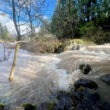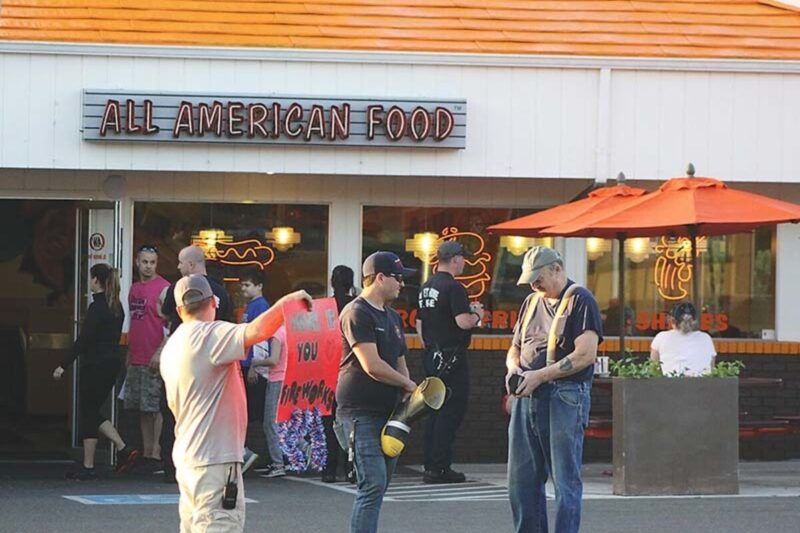Sean C. Morgan
The Sweet Home Fire and Ambulance District needs volunteer firefighters and more.
“Not only in our community, but every community across the nation, there is a decrease in volunteer firefighters,” said Volunteer Association Vice President Josh Marvin. The peak in volunteering for firefighters was in 1999, while the low point was 2011.
“Virtually every community with 10,000 or less population is served by volunteers. That hits them the hardest.”
The shortage means fewer people are available when the fire departments need them, Marvin said.
“Every large incident, volunteers are needed,” said Lt. Zach Lincoln, who is a full-time paid paramedic-firefighter. To recruit volunteers, “basically, we’ve kind of relied on word of mouth.”
The National Fire Protection Association recommends 14 firefighters on fire calls, Marvin said. On Thursday evening, the night department conducts drills, the fire department had nine. Currently, the department has 31 firefighter volunteers.
The district receives roughly 40 to 50 calls per year, primarily accidents and fires, for which it needs large numbers to respond, Marvin said.
“We need volunteers at all four stations,” Marvin said. Those stations are Crawfordsville, with three firefighter volunteers; Cascadia, with no volunteers; Foster, with six firefighter volunteers; and the Fire Hall, 1099 Long St., with 22 volunteers.
Fifty was the Sweet Home department’s peak number of volunteer firefighters, Lincoln said. The department has seven support volunteers.
People may not believe they are capable of being a firefighter, Lincoln said, but the district needs other volunteers as well, to help with medical calls, to support firefighters at incidents with cold water and Gatorade, refill air packs or provide cool towels to wrap around their necks.
Volunteers also assist with other work around the stations, such as lawn care, freeing up paid staff for other work, Marvin said.
Others have helped out with information technology, bringing the department into the 21st century, Lincoln said, but the top priority for the district is firefighters right now.
Marvin and Lincoln have theories why the level of volunteerism has fallen. Among them, Marvin said, is many residents work outside of town, but part of it is the department staff’s doing – relying on word of mouth to recruit, he said.
The district needs to do a better job reaching out to the public to let people know what they can do, Marvin said.
He and Lincoln believe the time needed for training can be a barrier for some volunteers as well.
“The requirements have become more difficult,” Lincoln said. Volunteer firefighters are required to spend 60 hours annually in training to maintain their certification. That requirement may be met through weekly drills held at 6:30 p.m. on Thursdays and burn-to-learn training. That follows 120 hours of initial training, which is held in Marcola and hosted by the Mohawk Fire District.
Initial training is held Friday through Sunday over six weekends. Dates and times have not been set yet. Interested persons should contact the fire district for further details at (541) 367-5882.
Marvin said the Volunteer Firefighter Association will host a meeting at 6:30 p.m. on June 11 at the Fire Hall for anyone who is interested in volunteering and their families so they can learn about the program and what to expect.
The ongoing training can be flexible, Marvin said. He goes into the Fire Hall on Fridays to find out if the district has any training going on.
Fighting fire is a just one of the jobs, Lincoln said. The district also needs volunteers to drive engines, the ladder truck, tenders and brush rigs. The district offers training and work in swift water rescue, diving, vehicle extrication and technical rope rescue, often used in responses to the Blue Pool at the east edge of Linn County. The district covers the cost of that training.
Volunteers with training also may respond to wildland fires in Oregon and California.
Volunteers receive $12 per call, Lincoln said. On wildland responses, eligible firefighters are paid $15.50 per hour 24 hours per day. After 40 hours, they receive overtime pay. During a two-week period, it can pay up to $7,500.
Normally, volunteers are expected to attend Thursday drills and to respond to the closest station when paged through an app that functions much like Pulse Point.
Firefighter volunteers must be 18 years old, pass a background check, have a driver’s license, pass a physical eligibility test and be able to attend the fire academy in Marcola.
Marvin, 36, who works for the Linn County Road Department, said he volunteered right out of high school “to explore a possible career path.” Since then he has served about 10 years as a volunteer firefighter.
“It’s just something I fell in love with,” Marvin said. “I’ve always been involved in giving back to the community.”
He also enjoys the sense of brotherhood in the fire service, he said, and it functions as a sort of second family.
Volunteers are normally members of the Volunteer Association. Among its activities, the association raises funds and runs the annual fireworks display, and it maintains a fund to help victims of fires. Women are welcome to serve as volunteers, but the wives of volunteers and paid staff formed their own Women’s Association, which helps support some functions of the district. Among its functions, its members run the annual Christmas Sharing Tree program.
“It’s another way to make a difference to the community and be a part,” Marvin said.
For more information, visit Sweet Home Volunteer Firefighter Association on Facebook or call the Fire and Ambulance District.





